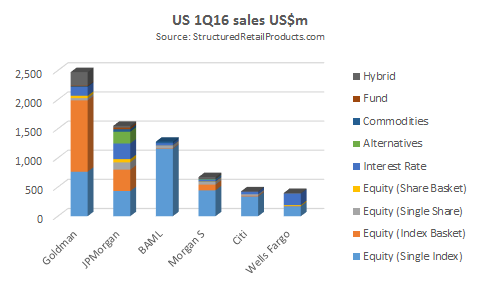Financial markets enjoyed a choppy ride during the first quarter of 2016 with concerns about the Chinese economy and the ongoing decline in oil prices contributing to higher levels of volatility and generally lower global equity prices. The S&P 500, which started the year on 2012.6bp, decreased by more than 9% over the first 28 trading days and remained dented throughout February, although by the end of the quarter the US benchmark had recovered any losses occurred by finishing on 2059.7bp.
SRP looked at the impact the volatile market conditions had on the 1Q16 results of five of the main US investment banks.
Goldman Sachs reported net revenues of US$6.34bn and net earnings of US$1.14bn for the first quarter ended March 31, 2016. Net revenues in investment banking were US$1.46bn, 23% lower than the first quarter of 2015 and 5% lower than the fourth quarter of 2015, according to the bank. Net revenues in fixed income, currency and commodities client execution (FICCCE) were US$1.66bn for 1Q16, 47% lower compared with the first quarter of 2015. FICCCE operated in a 'challenging environment characterised by economic uncertainty and difficult market-making conditions, which resulted in significantly lower net revenues across all major businesses compared with the first quarter of 2015', the bank said. Net revenues in equities, at US$1.78bn, were 23% lower than in 1Q15. The decrease in equities client execution reflected significantly lower net revenues in both cash products and derivatives, the bank said.
Goldman issued 290 structured products in the US during 1Q16 according to SRP data. The structures, of which more than half was linked to an equity index (including 86 products to the S&P 500), collected combined sales of US$2.5bn, confirming the bank's position as market leader in the US with a share of 20% of the market.
Goldman's Leveraged Notes (38148TLP2), which provide 200% upside participation in a weighted basket comprising the Eurostoxx 50 (58%), Topix (23%) and FTSE 100 (19%) were the best-selling US product in 1Q16. The note, which has a term of one-year, sold just over US$1bn during the subscription period.

JP Morgan reported 1Q16 net income of US$5.5bn and earnings per share of US$1.35. Corporate & investment bank (CIB) revenue of US$1.2bn was down 24% year-on-year (y-o-y). Markets revenue was down 13% y-o-y, reflecting an increase in the rates business which was more than offset by lower performance across other asset classes, according to the bank. Securities services revenue, at US$881m, was down 6% y-o-y, while credit costs of US$459m primarily reflected higher reserves driven by oil & gas and metals & mining, the bank said.
SRP data confirms that, with 459 structured products (US$1.6bn), JP Morgan was the most active issuer during 1Q16. At the same time, the bank's offering was the most diverse, with products available in nine different asset classes.
Bank of America (BAM) recorded revenues, net of interest expense, of US$19.7bn during the first quarter of 2016. Sales and trading revenue in the global markets business unit, excluding net debt valuation adjustments (DVA), was down 16% compared to 1Q15; fixed income was down 17%; and equities were down 11%, according to the bank.
When it comes to issuance of structured products, the bank is left behind by its competitors, although it more than makes up for it in sales volume (BAM issued 36 structured products worth US$1.3bn in 1Q16).

Citi reported net income for 1Q16 of US$3.5bn, or US$1.10 per diluted share, on revenues of US$17.6bn. This compared to net income of US$4.8bn (US$1.51 per diluted share), on revenues of US$19.7bn for the first quarter of 2015, according to the bank. Citi's market-sensitive products 'clearly suffered from weak investor sentiment during the quarter', stated Michael Corbat, CEO of Citi.
Citi launched 98 structured products worth US$427m in the US during 1Q16.
Wells Fargo, which issued 52 structured products with a sales volume of US$400m between January and March 2016, reported revenues, at US$22.2bn, were up 4% from the prior year. Net income stood at US$5.5bn compared with US$5.8bn in the first quarter of 2015 while total assets under management of US$481bn were down 2% from the previous year due to equity outflows and lower market valuations, partially offset by favourable fixed income and money market net client inflows, the bank said.
Morgan Stanley stated the first quarter was characterised by 'challenging market conditions and muted client activity'. The bank posted net revenues of US$7.8bn for the first quarter compared with US$9.9bn a year ago. Long-term unsecured debt outstanding at March 31, 2016 - which includes positive net issuance, and changes related to FX, interest rates, or movements in the reference price or index for structured notes - was US$163bn, up US$9bn versus December 31, 2015, the bank said. Unsecured debt issuance stood at US$13bn in 1Q16 (FY2015: US$34bn) while the figure for unsecured debt maturities, retirements and calls was US$8bn (FY2015: US$28bn). Total short-term and long-term maturities - which include plain vanilla (senior unsecured debt, subordinated debt, and trust preferred securities), structured notes and commercial paper, had a weighted average maturity of 6.2 years in 1Q16, according to the bank.
Morgan Stanley launched 131 structured products worth US$672m in the US during 1Q16.
Click the link to view the 1Q16 results for Bank of America, Citi, Goldman Sachs, JP Morgan, Morgan Stanley and Wells Fargo.
Barclays racks up over US$120m with S&P 500 digital play
USA Market Review - March 2016
BAML leads US sales in March, 64 products linked to ETFs launched
Product snapshot: CS deploys Bloomberg's WTI crude oil futures contracts index